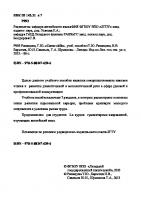Own Your Tech Career: Soft skills for technologists 9781617299070
Own Your Tech Career: Soft skills for technologists is a guide to taking control of your professional life. It teaches y
404 107 2MB
English Pages 264 Year 2021
Table of contents :
Own Your Tech Career
brief contents
contents
preface
acknowledgments
about this book
liveBook discussion forum
about the author
about the cover illustration
Introduction
1 Own your career
1.1 Job, career, success, and self
1.2 Start at the beginning: With yourself
1.3 What does success look like for you?
1.4 Creating a career plan for right now
1.5 Action items
2 Build and maintain your brand
2.1 Brand building: Know your audience
2.2 Social media and your brand
2.3 Your brand has a wide reach
2.4 Professionalism and your brand
2.5 How to sabotage your brand
2.6 Further reading
2.7 Action items
3 Network
3.1 Why networking?
3.2 The problem with digital communications
3.3 Ideas for in-person networking
3.4 Ideas for online networking
3.5 Etiquette for networking
3.5.1 In person
3.5.2 On LinkedIn
3.6 Becoming a confident networker
3.7 Action items
4 Be part of a technology community
4.1 The value of community to your career
4.2 Yes, you’re worthy of contributing
4.3 Ways to contribute and participate
4.4 Etiquette for participating
4.4.1 On Q&A websites
4.4.2 In open source projects
4.5 Action items
5 Keep your tech skills fresh and relevant
5.1 Fresh vs. relevant
5.2 Deciding what’s relevant
5.2.1 Proficient, not expert
5.2.2 Where to focus
5.3 Building strong learning muscles
5.4 Learning media
5.5 Assessing your relevancy
5.6 Tips for lifelong daily learning
5.7 Further reading
5.8 Action items
6 Show up as a professional
6.1 Be your word
6.1.1 Never promise what you cannot deliver
6.1.2 Always deliver what you promise
6.1.3 Be easy to work with
6.2 Be detailed and precise
6.3 Cut your losses when the time is right
6.4 Let Blue Sky mode happen
6.5 Draw a yellow line
6.6 Action items
7 Manage your time
7.1 Discipline, procrastination, and laziness
7.2 Time management
7.2.1 Time inventory: The TimeFlip technique
7.2.2 Time rationing: The Pomodoro technique
7.2.3 Time catalog: Knowing your capabilities
7.3 Multitasking
7.4 Action items
8 Handle remote work
8.1 The challenges of being remote
8.2 Creating a space
8.3 Creating a space when you have no space
8.4 Working with family
8.5 Adopting a routine
8.6 Explicitly defining a culture
8.7 Networking like you’re in the office
8.8 Remote work: Permanent or temporary?
8.9 Action items
9 Be a team player
9.1 The ups and downs of teams
9.2 A checklist for being a better team player
9.3 Dealing with less-effective teams and teammates
9.4 Contributing to an inclusive workplace
9.4.1 Help
9.4.2 Offer respect and support
9.5 Further reading
9.6 Action items
10 Be a team leader
10.1 The decision to lead
10.2 Leadership vs. management
10.3 The leader’s path
10.4 Getting into their context
10.5 Leading positively
10.6 Mistakes leaders make
10.7 Leadership beyond leading
10.8 Before moving into leadership
10.8.1 Don’t get promoted to your level of incompetence
10.8.2 Learn leadership
10.8.3 Measure your own success
10.9 Further reading
10.10 Action items
11 Solve problems
11.1 Problem-solving vs. troubleshooting
11.2 Clearly state the problem
11.3 Identify your levers
11.4 Negotiating solutions
11.5 Action items
12 Conquer written communications
12.1 Communicating is telling a story
12.1.1 The rules of storytelling
12.1.2 Applying storytelling to business communication
12.1.3 What about mundane, everyday communication?
12.2 Facing our fear of communicating
12.2.1 Analyze the causes of your fear
12.2.2 Address the causes of your fear
12.2.3 Conquer fear in written communications
12.3 Applying structure to your storytelling
12.4 Practice, practice, practice
12.5 Common written defeaters
12.5.1 Avoid passive voice
12.5.2 Prune that flowery garden
12.6 Action items
13 Conquer verbal communications
13.1 Stepping up to verbal communications
13.2 Conquering your fear of speaking
13.2.1 Fear of not having all the answers
13.2.2 Fear of being judged
13.3 Common verbal defeaters
13.4 Finding the right amount of assertive
13.5 Persuasion and the art of listening
13.6 Action items
14 Resolve conflicts
14.1 Conflict can be healthy and even deliberate
14.2 Seeking context
14.3 Returning to first principles
14.4 Relying on data
14.5 Using decision-making frameworks
14.6 A win doesn’t matter as much as the outcome
14.7 Action items
15 Be a data-driven, critical thinker
15.1 In business, never “believe”
15.2 Be a data-driven, critical thinker
15.3 Be data-driven
15.4 Beware the data
15.5 Further reading
15.6 Action items
16 Understand how businesses work
16.1 Businesses are people too
16.1.1 Businesses and their relationships
16.1.2 Customers and employees
16.1.3 One-sided relationships
16.1.4 Dealing with changes in the relationship
16.2 How businesses really make money
16.3 What does your business sell?
16.3.1 Example 1: Terri’s International Bulbs
16.3.2 Example 2: Martin’s Theme Parks
16.3.3 Example 3: Pat’s Fruity Clothing
16.3.4 Know the details of the business
16.4 Understanding risk and reward
16.5 Further reading
16.6 Action items
17 Be a better decision-maker
17.1 Deciding who decides: Decision-making frameworks
17.2 Deciding what to do: OKRs, rocks, and pebbles
17.2.1 Rocks and pebbles
17.2.2 OKRs
17.2.3 Priorities, priorities
17.3 Deciding what to drop: Opportunity cost
17.4 Deciding what’s enough: Good, better, best
17.5 Deciding what to believe: Being data-driven
17.6 Deciding together: How to negotiate
17.7 Further reading
17.8 Action items
18 Help others
18.1 Why help?
18.2 Yes, you can
18.2.1 The toxic relationships that keep us from teaching
18.2.2 You are definitely worthy of teaching
18.3 How humans learn
18.4 The value of repetition
18.5 Getting in and doing it
18.6 Why analogies work . . . and how they can fail
18.7 Do it like Socrates
18.8 The importance of sequencing
18.9 Rest time is crucial
18.10 Further reading
18.11 Action items
19 Be prepared for anything
19.1 What can happen?
19.2 Basic preparedness goals
19.3 Cash on hand and credit
19.4 Social safety nets
19.5 Insurance
19.6 Prestaged job hunt tools
19.7 Action items
20 Business math and terminology for technologists
20.1 How much do you cost?
20.2 Reading a P&L statement
20.2.1 Revenue
20.2.2 Expenses
20.3 Averages
20.4 OpEx and CapEx
20.4.1 Understanding the two types of expenses
20.4.2 Driving business decisions
20.5 Business architecture
20.6 Further reading
20.7 Action items
21 Tools for the modern job hunt
21.1 Job hunt tasks to do now
21.2 Review your brand
21.2.1 Your professional brand and the job hunt
21.2.2 Reviewing your public footprint
21.2.3 How would others describe your brand?
21.3 Update your résumé
21.3.1 Résumé rules
21.3.2 Starting your résumé
21.3.3 Every résumé is unique
21.3.4 Analyze the job posting
21.3.5 Writing your résumé
21.3.6 Formatting your résumé
21.3.7 Should you hire a résumé writer?
21.4 Nailing the interview
21.5 Understanding compensation packages
21.5.1 Compensation package elements
21.5.2 Negotiating your compensation package
21.6 Further reading
21.7 Action items
index
A
B
C
D
E
F
G
H
I
J
K
L
M
N
O
P
Q
R
S
T
U
V
W
Y
Own Your Tech Career
brief contents
contents
preface
acknowledgments
about this book
liveBook discussion forum
about the author
about the cover illustration
Introduction
1 Own your career
1.1 Job, career, success, and self
1.2 Start at the beginning: With yourself
1.3 What does success look like for you?
1.4 Creating a career plan for right now
1.5 Action items
2 Build and maintain your brand
2.1 Brand building: Know your audience
2.2 Social media and your brand
2.3 Your brand has a wide reach
2.4 Professionalism and your brand
2.5 How to sabotage your brand
2.6 Further reading
2.7 Action items
3 Network
3.1 Why networking?
3.2 The problem with digital communications
3.3 Ideas for in-person networking
3.4 Ideas for online networking
3.5 Etiquette for networking
3.5.1 In person
3.5.2 On LinkedIn
3.6 Becoming a confident networker
3.7 Action items
4 Be part of a technology community
4.1 The value of community to your career
4.2 Yes, you’re worthy of contributing
4.3 Ways to contribute and participate
4.4 Etiquette for participating
4.4.1 On Q&A websites
4.4.2 In open source projects
4.5 Action items
5 Keep your tech skills fresh and relevant
5.1 Fresh vs. relevant
5.2 Deciding what’s relevant
5.2.1 Proficient, not expert
5.2.2 Where to focus
5.3 Building strong learning muscles
5.4 Learning media
5.5 Assessing your relevancy
5.6 Tips for lifelong daily learning
5.7 Further reading
5.8 Action items
6 Show up as a professional
6.1 Be your word
6.1.1 Never promise what you cannot deliver
6.1.2 Always deliver what you promise
6.1.3 Be easy to work with
6.2 Be detailed and precise
6.3 Cut your losses when the time is right
6.4 Let Blue Sky mode happen
6.5 Draw a yellow line
6.6 Action items
7 Manage your time
7.1 Discipline, procrastination, and laziness
7.2 Time management
7.2.1 Time inventory: The TimeFlip technique
7.2.2 Time rationing: The Pomodoro technique
7.2.3 Time catalog: Knowing your capabilities
7.3 Multitasking
7.4 Action items
8 Handle remote work
8.1 The challenges of being remote
8.2 Creating a space
8.3 Creating a space when you have no space
8.4 Working with family
8.5 Adopting a routine
8.6 Explicitly defining a culture
8.7 Networking like you’re in the office
8.8 Remote work: Permanent or temporary?
8.9 Action items
9 Be a team player
9.1 The ups and downs of teams
9.2 A checklist for being a better team player
9.3 Dealing with less-effective teams and teammates
9.4 Contributing to an inclusive workplace
9.4.1 Help
9.4.2 Offer respect and support
9.5 Further reading
9.6 Action items
10 Be a team leader
10.1 The decision to lead
10.2 Leadership vs. management
10.3 The leader’s path
10.4 Getting into their context
10.5 Leading positively
10.6 Mistakes leaders make
10.7 Leadership beyond leading
10.8 Before moving into leadership
10.8.1 Don’t get promoted to your level of incompetence
10.8.2 Learn leadership
10.8.3 Measure your own success
10.9 Further reading
10.10 Action items
11 Solve problems
11.1 Problem-solving vs. troubleshooting
11.2 Clearly state the problem
11.3 Identify your levers
11.4 Negotiating solutions
11.5 Action items
12 Conquer written communications
12.1 Communicating is telling a story
12.1.1 The rules of storytelling
12.1.2 Applying storytelling to business communication
12.1.3 What about mundane, everyday communication?
12.2 Facing our fear of communicating
12.2.1 Analyze the causes of your fear
12.2.2 Address the causes of your fear
12.2.3 Conquer fear in written communications
12.3 Applying structure to your storytelling
12.4 Practice, practice, practice
12.5 Common written defeaters
12.5.1 Avoid passive voice
12.5.2 Prune that flowery garden
12.6 Action items
13 Conquer verbal communications
13.1 Stepping up to verbal communications
13.2 Conquering your fear of speaking
13.2.1 Fear of not having all the answers
13.2.2 Fear of being judged
13.3 Common verbal defeaters
13.4 Finding the right amount of assertive
13.5 Persuasion and the art of listening
13.6 Action items
14 Resolve conflicts
14.1 Conflict can be healthy and even deliberate
14.2 Seeking context
14.3 Returning to first principles
14.4 Relying on data
14.5 Using decision-making frameworks
14.6 A win doesn’t matter as much as the outcome
14.7 Action items
15 Be a data-driven, critical thinker
15.1 In business, never “believe”
15.2 Be a data-driven, critical thinker
15.3 Be data-driven
15.4 Beware the data
15.5 Further reading
15.6 Action items
16 Understand how businesses work
16.1 Businesses are people too
16.1.1 Businesses and their relationships
16.1.2 Customers and employees
16.1.3 One-sided relationships
16.1.4 Dealing with changes in the relationship
16.2 How businesses really make money
16.3 What does your business sell?
16.3.1 Example 1: Terri’s International Bulbs
16.3.2 Example 2: Martin’s Theme Parks
16.3.3 Example 3: Pat’s Fruity Clothing
16.3.4 Know the details of the business
16.4 Understanding risk and reward
16.5 Further reading
16.6 Action items
17 Be a better decision-maker
17.1 Deciding who decides: Decision-making frameworks
17.2 Deciding what to do: OKRs, rocks, and pebbles
17.2.1 Rocks and pebbles
17.2.2 OKRs
17.2.3 Priorities, priorities
17.3 Deciding what to drop: Opportunity cost
17.4 Deciding what’s enough: Good, better, best
17.5 Deciding what to believe: Being data-driven
17.6 Deciding together: How to negotiate
17.7 Further reading
17.8 Action items
18 Help others
18.1 Why help?
18.2 Yes, you can
18.2.1 The toxic relationships that keep us from teaching
18.2.2 You are definitely worthy of teaching
18.3 How humans learn
18.4 The value of repetition
18.5 Getting in and doing it
18.6 Why analogies work . . . and how they can fail
18.7 Do it like Socrates
18.8 The importance of sequencing
18.9 Rest time is crucial
18.10 Further reading
18.11 Action items
19 Be prepared for anything
19.1 What can happen?
19.2 Basic preparedness goals
19.3 Cash on hand and credit
19.4 Social safety nets
19.5 Insurance
19.6 Prestaged job hunt tools
19.7 Action items
20 Business math and terminology for technologists
20.1 How much do you cost?
20.2 Reading a P&L statement
20.2.1 Revenue
20.2.2 Expenses
20.3 Averages
20.4 OpEx and CapEx
20.4.1 Understanding the two types of expenses
20.4.2 Driving business decisions
20.5 Business architecture
20.6 Further reading
20.7 Action items
21 Tools for the modern job hunt
21.1 Job hunt tasks to do now
21.2 Review your brand
21.2.1 Your professional brand and the job hunt
21.2.2 Reviewing your public footprint
21.2.3 How would others describe your brand?
21.3 Update your résumé
21.3.1 Résumé rules
21.3.2 Starting your résumé
21.3.3 Every résumé is unique
21.3.4 Analyze the job posting
21.3.5 Writing your résumé
21.3.6 Formatting your résumé
21.3.7 Should you hire a résumé writer?
21.4 Nailing the interview
21.5 Understanding compensation packages
21.5.1 Compensation package elements
21.5.2 Negotiating your compensation package
21.6 Further reading
21.7 Action items
index
A
B
C
D
E
F
G
H
I
J
K
L
M
N
O
P
Q
R
S
T
U
V
W
Y


![Own Your Tech Career: Soft skills for technologists [1 ed.]
1617299073, 9781617299070](https://ebin.pub/img/200x200/own-your-tech-career-soft-skills-for-technologists-1nbsped-1617299073-9781617299070.jpg)







